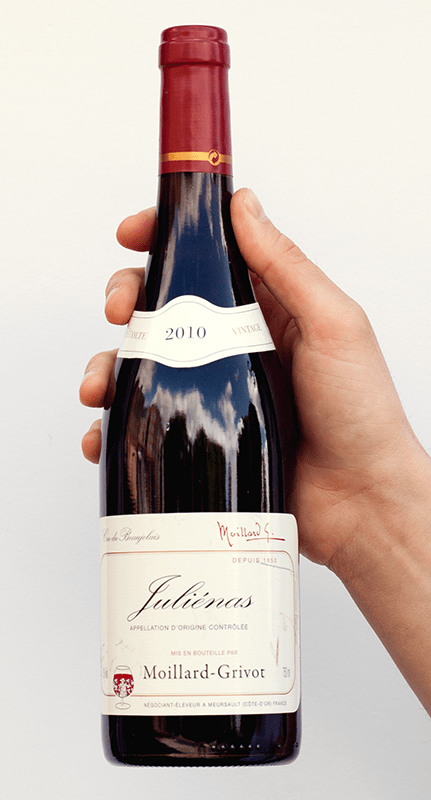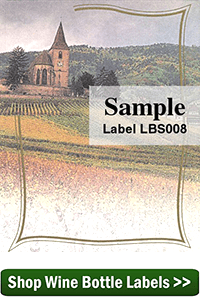 As a home winemaker, you don’t have to worry about conforming to all the strict rules regarding wine bottle labels that are in place for commercial winemaking. However, creating wine labels that will allow you to easily identify your wine in your cellar is highly recommended.
As a home winemaker, you don’t have to worry about conforming to all the strict rules regarding wine bottle labels that are in place for commercial winemaking. However, creating wine labels that will allow you to easily identify your wine in your cellar is highly recommended.
Simply writing a “Cab” for Cabernet Sauvignon or “P” for peach on the top of the cork or side of the bottle with a grease pencil isn’t going to cut it. The information that goes on the wine label is going to become more important as you start producing more styles and vintages.
Designing and creating a wine bottle label system that helps identify exactly what’s in the bottle and that looks stylish and professional if you’re gifting it for a friend or family member will save you a lot of headaches in the future.
You can as much or as little information on the wine bottle label as you’d like. You can make the wine bottle label as simple or as complex as you’d like. This is because it is your wine. You are the winemaker and are not bound by strict wine bottle label laws.
Each country has different laws in regards to what information must go on the wine label, however, most of them have basic similarities that you can apply to your own wine label. If you’re looking to design a wine bottles label that’s similar to those from commercial wines, you’ll need a few standard pieces of information.
- Brand Name: What do you want to name the wine? Joe’s Amazing Chardonnay? Sweet Peachy McGee? You can get creative with this one!
- Vintage: What year were the grapes or other fruits picked?
- Variety/Fruit Information: What’s in the bottle? Is it Sauvignon Blanc? Or is it Raspberry wine?
- Region/Geographical Location:
 Where did you make the wine? Where did the fruit come from? You could very well be making your wine in a different location from where you purchased the fruit, and that’s OK! Since you’re not bound by any wine bottle label laws, you have the freedom to write what you want here. On commercial bottles, it must be made clear where the fruit is coming from as well as the location of the winery.
Where did you make the wine? Where did the fruit come from? You could very well be making your wine in a different location from where you purchased the fruit, and that’s OK! Since you’re not bound by any wine bottle label laws, you have the freedom to write what you want here. On commercial bottles, it must be made clear where the fruit is coming from as well as the location of the winery.
- Alcohol content: This is information that goes on any wine label you see on the commercial shelf. It might be nice to include this on your wine label as well, particularly if you’re going to be gifting it to someone else that isn’t familiar with how you made the wine.
- Volume: This information indicates the volume of wine contained within the bottle.
As a home winemaker, what information goes on your wine labels is completely up to you. You have freedom to do anything you want with your wine label. However, it is important to label your wines in such a way that you can easily identity them. And, if you’re giving the wine to someone as a gift, it would be nice to design your wine label in such a way that it creates a little fun, as well.
—–
Ed Kraus is a 3rd generation home brewer/winemaker and has been an owner of E. C. Kraus since 1999. He has been helping individuals make better wine and beer for over 25 years.

I have a recipe for orange wine that only takes 2.5 gallons of water.
When I transfer the liquid into the carboy, do I fill it to the top with additional water to the container to bring it up to the neck of the bottle?
Barney,
I personally like a very full bodied wine. If I was following your recipe, I would double it and make the full 5 gal. It can be watered down, but will lose a lot of body, flavor, and alcohol content..
I personally have made over 40 different flavors of fruit wines over the last 10 years. I would love you orange wine recipe, if it’s good.
Barney, it depends on how much head-space we are talking about. If you only need to add, say, a pint of water, then okay. Not a problem. But if you have a 5 gallon carboy with only 2.5 gallons of wine to go in it, then you have a problem. In that situation you need to find a smaller carboy or a series of smaller containers to eliminate the head-space.
Great summary of things to include on a wine label. It never occurred to me to include my location. I usually forget to include the alcohol content, too. (I’m a designer and make beautiful labels!)
Wine Bottle Label suggestion—I use stick on labels from Avery. You can create the design you want using one of their free templates and print it using your computer printer. I find that the 3 1/3" x 4" size works well on the 750ml bottle.
I thought it nice to take photo’s of the/my actual frui tI grew and harvested before it was harvested, I took these photo’s to zazzle.com and made my own labels and had zazzle print them. I also used a permanent marker to list the vintage count and alcohol %, as well as when was bottled on the back side of the shrink wrap top once sealed so as to be able to later discard the used shrink wrap and still be able to recycle my bottles and recycle the labels for morte than one usage!
My peach labels were photo’s from my own trees in the orchard, the Japanese Persimmon also from my own trees as well as my own strawberry and muscadine harvests from my own crops as well as others. I made a dandelion and uses the photo of the field the pedals were harvested from while dandelion flowers were in full bloom across the field. Made great labels with pictures of the fruit variety and tells the real story of the beginning of the wine!
I would like to find a wine label that comes off easily with no scrubbing! Most of the time I just tape a piece of paper to the bottles I keep for myself, but print actual labels for the bottles I give out. My friends, of course, want me to keep the wine coming so they always give me back my bottles for my ‘next batch’. Then I end up scrubbing label residue off bottles anyway! Yuck! Since I’m a disabled wine maker, I try to do as little hard labor as possible. LOL! Does anyone have a recommendation on an easy to peel off label that leaves no sticky residue behind?
I use the glue sticks to attach my labels. They come off with a little hot water. Good luck!
I visit local wineries and find which labels come off easily they will give you as many bottles as you need free
I, like Dale said, use a glue stick or good old Elmer’s white glue diluted with about 30-50% water to glue ratio on my labels. Brush it on the label and slap ‘er on the bottle! With home made paper labels, they fall right off in hot water. I have about 90 identical dead leaf green hock bottles that a friend was bringing me from someone he knew who drank only one kind and brand of wine. (These bottles are about $20.00 a case to buy new) The labels were tough to get off until I found out about oxy clean. A teaspoon or two of oxy clean powder in a bucket with very hot water inside and out of the bottles (so they sink) for about 10 – 30 minutes and most labels will virtually fall right off. Even those tough commercial labels will be a heck of a lot easier to remove. You may need to use the scrubbie side of a kitchen sponge to remove a little remaining glue, but it will be well softened by the oxy clean. Cheers!
Neato labels come off really easy. I’ve been using them for couple years now.
I agree, Harry. I personally use the Avery 2X4 inch labels on mine.
We make a lot of sweet wines as well as dry so there is another piece of information we include on all our labels, the Brix. We find that information very helpful when we pair up the wine to our friends preferences. Also by measuring the brix at time of bottling, and making adjustments to sweetness as needed, we can ensure our wine is consistent from batch to batch. I wish commercial wine makers would do the same, it would really help in making wine selections.
It’s interesting to read about what sort of info is on wine bottles and how it helps consumers. It makes sense that it could be helpful to know exactly what wine you’re getting if you’re buying vintage or older wines. It’s something to remember because I want to make custom labels and I think that taking inspiration from old wine bottles could be good.
I use card stock and make my own labels. I then punch a hole in the top and use string to create a looop. I then slip the string and label over the neck of the bottle. I like my labels to look a bit rustic and I swear I will never attach a label with any kind of adhesive after scrubbing so many labels off.
8 labels on a Avery Full Sheet peel & stick label, then cut with paper cutter. Remove by soaking in water, scrape, soak, scrub. Sometimes need to scrub with comet. Only real problem is ink fade & smear if gets wet.
[ Photo of ]
[ Cherries ] (or other fruit)
[ Here ]
Cherry Bomb (name)
Cherry (what fruit)
17 % Alcohol (as measured)
Semi-Sweet (as tasted)
JJM 2016
I make many fruit wines and agree with the oxyclean and a dash of dawn in my utility sink. Submerge the bottles in the hot water and after a couple of hours most peel off or can be scraped easily with an old ice scraper. The labels are created from pictures taken of the fruits or downloaded and printed on Sticker Photo Paper from LD products that I found online. It also comes off in the bath on those returned bottles.
Do you have any resources or links you could point us to? Finding out what is required on the bottle label, as opposed to the marketing side of it seems to abbe difficult even for folks that have been doing this a while.
Many Thanks..